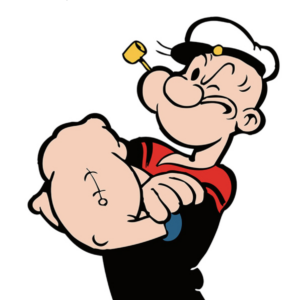In early 1929, a young artist stared blankly at his drawing board. Though Elzie Segar was a rising cartoonist, at that moment he was stumped.
For 10 years, he had been drawing the syndicated “Thimble Theatre” comic strip. After a slow start, it gradually developed a following during the 1920s as more and more newspapers began carrying it.
The star of the storyline was long, lean, and frequently lazy Harold Hamgravy (eventually shortened to just Ham Gravy) and his fussy, no-nonsense girlfriend, Olive Oyl. Olive’s nearsighted brother Castor Oil joined in their adventures.
Now Segar was looking for a new wrinkle. Ham Gravy and Castor Oil devised a scheme to break the bank at a casino on Dice Island. But first, they needed an experienced sailor to skipper their boat.
As Segar mulled over possibilities, he did what countless novelists, painters and musicians had done for centuries when the Muse refused to come to the rescue. He reached into his own personal experience.
Segar thought back to his boyhood in the Illinois town of Chester, a little county-seat community sitting proudly atop a bluff overlooking the Mississippi River south of St. Louis. Like all the kids in town, Segar had been mesmerized listening to the astonishing tales told by Frank “Rocky” Fiegal.
Rocky was the town character. And that was putting it mildly. In a region known for colorful coots, Rocky stood out from the pack.
Born in Poland in 1868, he had come to the United States with his parents as a child. But a Norman Rockwell-type small-town life held little appeal for him, so he went off to sea. Rocky spent the next 20 years circling the globe in the merchant marines.
The lure of home ultimately proved too strong to resist. It drew him back to Chester, where he eventually took a job as a bouncer at the popular Weisbusch’s Tavern. Strong as an ox, Rocky enjoyed jumping into fights as often as he broke them up. And more often than not, he emerged from those tussles as the victor.
Rocky became more than the drinking establishment’s muscle. He soon turned into its star attraction. He spent hours at the bar, regaling patrons with tales both tall and short of his adventures on the seven seas.
He looked the part of a world-traveling adventurer, too. Powerfully built, he perpetually had a pipe stuck in one corner of his mouth as he talked non-stop out of the other as he spun his incredible yarns.
And there was his eye. One fight too many had left him with an injury that led to a second nickname: Popeye.
As Segar mulled the sailor he needed for his comic strip, he ultimately decided, “Why create someone from scratch when I already know the perfect one?”
And so Popeye the Sailor Man first appeared in the nation’s funny pages on January 17, 1929. It was initially intended to be a short run. Popeye would get the gang to the island for their caper, bring them back, and that would be that. But things didn’t turn out that way.
Readers wrote in droves, asking to see more of the outlandish seaman. Popeye was back by March.
Popeye’s return brought more readers, and that, in turn, brought more papers picking up the comic. The squint-eyed sailor soon pushed Ham Gravy out of the storyline and stole his girl. Olive Oyl (who was initially less than impressed by the burly, pipe-puffing sailor) became his devoted sweetheart.
And what about Rocky back in Chester? He loved it! He ate up his new celebrity status with a spoon. Segar had called Rocky and asked his approval of using his story in the strip. Rocky was flattered and eagerly agreed. To his immense credit, even though there was no formal agreement between them, Segar sent Rocky a percentage of the money he made off the feature right up to the cartoonist’s death from leukemia at age 43 in 1938.
Rocky was a more prominent local celebrity than ever. People couldn’t resist taking visitors to the tavern to meet the real Popeye, and Rocky couldn’t resist retelling the stories he had repeated thousands of times before.
When he passed away at age 79 in 1947, he was buried under a tombstone that modestly says, “Inspiration for Popeye the Sailor Man.” Occasionally, a fan will leave a can of spinach in tribute to the town character turned cartoon icon who was always “strong to da finish.”

